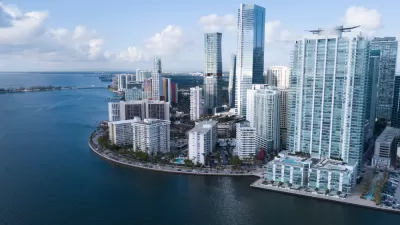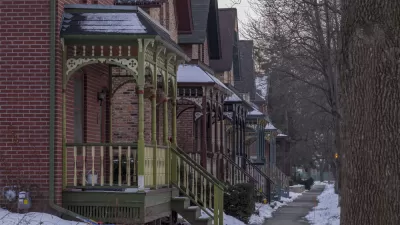Waterfront views and large parcels of vacant land should be a good urban revitalization in a growing city like Philadelphia, but the Central Delaware waterfront has fallen short of expectations.
Inga Saffron reviews the goals and results of a master plan approved in 2011 to remake the Central Delaware waterfront in Philadelphia.
The key approach of this plan, according to Saffron, was to aim for something different than the skyscraper-lined model of Vancouver and Miami.
By spacing out those smaller buildings, the thinking went, the city would create the beginnings of a true urban streetscape along Delaware Avenue. The mid-rises would populate the river, bringing just enough people to Delaware Avenue to support retail and justify adding a trolley line. The waterfront’s zoning was adjusted to make it easy to erect buildings under 25 stories, using a category called CMX-3.
While that seemed like a sound strategy at the time, Saffron makes the case that the results in 2019 have fallen far short of the ambitions described in 2011.
"Only one mid-rise has gone up over the last decade: PMC’s 16-story One Water Street, next to the Ben Franklin Bridge. Virtually every other residential project has been townhouses," reports Saffron. The maximum extent of the building envelope has not been realized, and the city is falling short of its vision for a "walkable, mixed-use riverfront neighborhood."
Saffron digs into more detail about why the townhomes that have been developed since 2011 fall short of the vision established by the Master Plan for the Central Delaware. There's even the development of a cap park to consider (work started in 2018), but even that hasn't convinced developers of adjacent projects to ditch to townhome development scheme.

Planetizen Federal Action Tracker
A weekly monitor of how Trump’s orders and actions are impacting planners and planning in America.

San Francisco's School District Spent $105M To Build Affordable Housing for Teachers — And That's Just the Beginning
SFUSD joins a growing list of school districts using their land holdings to address housing affordability challenges faced by their own employees.

The Tiny, Adorable $7,000 Car Turning Japan Onto EVs
The single seat Mibot charges from a regular plug as quickly as an iPad, and is about half the price of an average EV.

Seattle's Plan for Adopting Driverless Cars
Equity, safety, accessibility and affordability are front of mind as the city prepares for robotaxis and other autonomous vehicles.

As Trump Phases Out FEMA, Is It Time to Flee the Floodplains?
With less federal funding available for disaster relief efforts, the need to relocate at-risk communities is more urgent than ever.

With Protected Lanes, 460% More People Commute by Bike
For those needing more ammo, more data proving what we already knew is here.
Urban Design for Planners 1: Software Tools
This six-course series explores essential urban design concepts using open source software and equips planners with the tools they need to participate fully in the urban design process.
Planning for Universal Design
Learn the tools for implementing Universal Design in planning regulations.
Smith Gee Studio
City of Charlotte
City of Camden Redevelopment Agency
City of Astoria
Transportation Research & Education Center (TREC) at Portland State University
US High Speed Rail Association
City of Camden Redevelopment Agency
Municipality of Princeton (NJ)





























